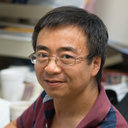Anti-TB polyynes from the roots of Angelica sinensis.
Ključne riječi
Sažetak
Following chemotaxonomic evidence, the PE and CHCl(3) extracts of the roots of the botanical Angelica sinensis (Oliv.) Diels (Dang Gui) were investigated for in vitro anti-TB activity, in parallel to studying their serotonergic and GABAergic potential. The activities were confirmed to overlap chemically with the neurotropic active principles present in medium lipophilic fractions. Phytochemical investigations led to the isolation of five polyynes: falcarindiol (1), 9Z,17-octadecadiene-12,14-diyne-1,11,16-triol,1-acetate (2), oplopandiol (3), heptadeca-1-ene-9,10-epoxy-4,6-diyne-3,8-diol (4) and the new polyyne 8-hydroxy-1-methoxy-(Z)-9-heptadecene-4,6-diyn-3-one (5), as characterized by spectroscopic techniques including 1D, 2D NMR and HR-MS. All compounds were tested against two pathogenic strains of Mycobacterium tuberculosis (H37Rv and Erdman) in vitro in a microplate Alamar Blue assay (MABA). The most potent anti-TB constituents were 1 and 2, exhibiting MIC values of 1.4-26.7 microg/mL; 3 showed moderate MICs (49.5 and 50.2 microg/mL, respectively) while 4 and 5 were weakly active (MIC > 60 microg/mL). Notably, none of the five compounds exhibited significant cytotoxicity against Vero cells. These findings not only reveal a new potential area of therapeutic value for A. sinensis, but also underline the role of polyynes as anti-TB active principles in ethnobotanical preparations, and as lead compounds.


